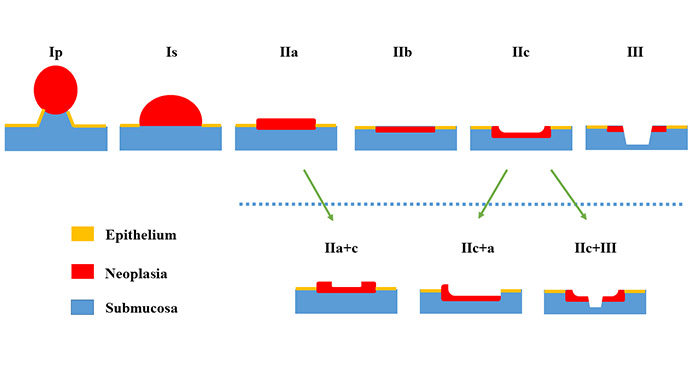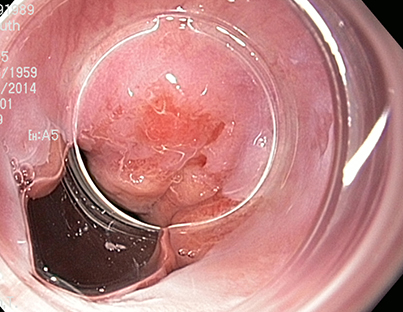Paris Classification: Early Barrett Cancers
Alexander Meining, Ulm | Thomas Rösch, Hamburg
The Paris classification for superficial tumors, which is presented and discussed in detail in the introductory part should be used in a standardized endoscopic terminology. In the following the schematic representation of this classification:

In the following, examples for superficial/early Barrett lesions of the esophagus are shown. Here, flat and sessilelesions are predominant, pedunculated tumors are rare. Sessile tumor with substantial intraluminal growth are often no early cancers any more; the same is the case with exavated lesions of different extent (type IIc or even III). From a clinical standpoint, in stage T1sm1 (= bis 500 µm) endoscopic resection is con sidered curative by some, if the other criteria are low risk (G1/2, L0, V0, R0), but evidence is limited.
Generally, many of the superficial/early Barrett lesions, which are often diagnosed on routine random biopsy, require then careful and meticulous endoscopic screening using good sedation, cleaning of the esophagus, modern technology with HD endoscopes and image processing, caps and staining (acetic acid).
Examples Barrett Esophagus Neoplasia 1: Type I sessile/elevated
Histology: surprisingly T1m2, basal R0 after ESD
Histology: also here surprisingly mucosal cancer (T1m3), although this patient underwent surgery due to the macroscopic suspicion of deppeter infiltration. In both cases, the lesions have a basal indentation almost like a broad stalk, so that differentiation is between types I-s and I-p.
Examples Barrett Esophagus Neoplasia 2: Type I flat-elevated
Histology: T1m3. This lesion is best visualized (in the presence of a very short Barrett) with a soft distance cap; this patient underwent surgery due to the macroscopic suspicion of deeper infiltration (surgical pathology again T1m3 N0)
Histology: T1m3.
Histology: T1m3, basal R0; also here, the best visualization of the pattern changes of this only sligthtly elevated lesion is with a cap.
Examples Barrett Esophagus Neoplasia 3: Type IIa+c flat-elevated with central depression
Histology: T1 m2, basal R0.
Histology: T1 sm1. This lesion has a large lateral extension and central depressions
Examples Barrett Esophagus Neoplasia 4: Type II b completely flat
Histology: T1m3. This flat lesion is much better demarcated after staining with acetic acid
Histology: T1m3. This lesion at the cardia in the present of a short Barrett is well visualized only with a cap and shows growth undermining the squamous epithelium. It can be debated whether it should be classified type IIb or IIa.
Histology: T1m3. This young patient had multiple mucosal cancers on biopsied and was therefore operated (operative histology confirmed mucosal spread)..
Histology: T1m. This completel flat lesion is visualized by its different colour and pattern.
Histology: T1m. This almost completely flat lesions (perhaps centrally minimally depressed) is mainly visualized by ist different pattern on imaging with NBI, acetic acid and cap.
Beispiele Barrett-Ösophagus 5: Typ IIc eingesunken
In these examples, sometimes a peripheral elevation is seen, so classification could also be type IIa+c
Histology after EMR: T1 sm1, despite only discrete depression on the lower margin of the image
AND: The extent of the depression on macroscopic inspection also depends on the degree of luminal insufflation
Examples Barrett Esophagus Neoplasia 6: Type III excavated/ulcerated
Histology: T1 sm1, basal R0; the lesion is minimally elevated around the exulceration (type II-a+c ?)
Histology: T1 sm1, basal R0 in an inoperable patient; the lesion is excavated and shows, that there is a variable transition between depressed (type IIc) and excavated (type III) which is subject to interpretation issues






























